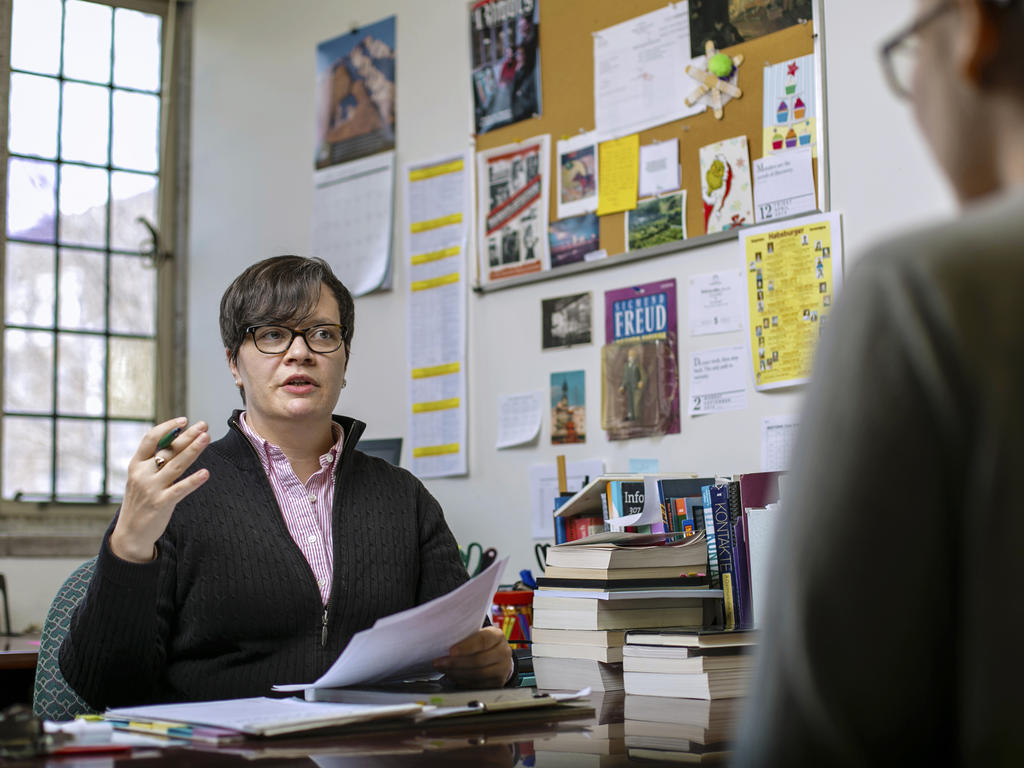By Lesley Young
Elizabeth Bridges was one of those kids who always had a comic book in her hands. It’s no surprise that when browsing in a bookstore as an adult, a graphic novel might catch her eye. One book in particular turned her head a few extra degrees, and the fallout has been tremendous.
“The cover is really captivating. It shows the Brandenburg Gate in the background, a heap of rubble in the foreground, and a little girl with a flower sitting on the heap of rubble. Everything in the picture is in black and white except for the little girl and the flower,” the assistant professor of German says. “The minute I saw it, before I even opened it, I could tell what it was about. I thought, ‘Why not use it to teach students?’”
The book is Der erste Frühling, and is, of course, in German. The bookstore was in Munich. The title, which means “the first spring,” tells the story of a young girl and her family in Berlin during 1945, and Bridges has employed the book in a Topics in German Literature, Culture and Society class, among other courses.
“When students get to the intermediate levels of language learning and they have to start reading more authentic texts, it can be very intimidating. I thought graphic novels might make that transition easier,” Bridges says. “The pictures give students something to hang on to, and when they can read a text meant for a German-speaking audience, it gives them a sense of accomplishment with the language.”
Since she started teaching with the book, Bridges has continued to use it along with other graphic novels in her classes. She has become an authority on the use of the genre in teaching college-level German. In 2009 she published the article “Bridging the Gap: A Literacy-Oriented Approach to Teaching the Graphic Novel,” and won the 2010 Best Article Award from the American Association of Teachers of German (AATG). She has also given numerous conference presentations, conducted panels, and provided workshops on the use of graphic novels in the classroom. Her work has inspired further research on the topic, including a webinar produced by the AATG.
“There hadn’t been real research about it of any kind, at least not in any area other than English as a second language,” she says. “Developing literacy in a foreign language is kind of the same process as when you’re developing literacy in your own language. The literacy-oriented model for graphic novels was something nobody had published on before. It seems to be widely accepted now.”
Inspired by Bridges’ research, Duke University acquired several hundred graphic novels for their library and invited her to present a workshop to its graduate students in modern languages. She served as a consultant on a project at Kutztown University in Pennsylvania, where a colleague developed a way to assess the language proficiency level of graphic novels and also created an extensive annotated bibliography of German graphic novels for use by instructors in selecting texts.
“It’s been this great ongoing development process, and the teaching of graphic novels has become a common practice throughout the discipline,” Bridges says.
Bridges plans to develop an entire course geared toward fourth-semester students based on graphic novels. “That’s when students start really confronting authentic material from German culture. I could start with Medieval illuminated texts and go all the way up to the Internet,” she says. “Graphic novels aren’t going to go away. You find shelves of them in every bookstore, many of them critically acclaimed. They make language learning a lot more fun and relevant.”
